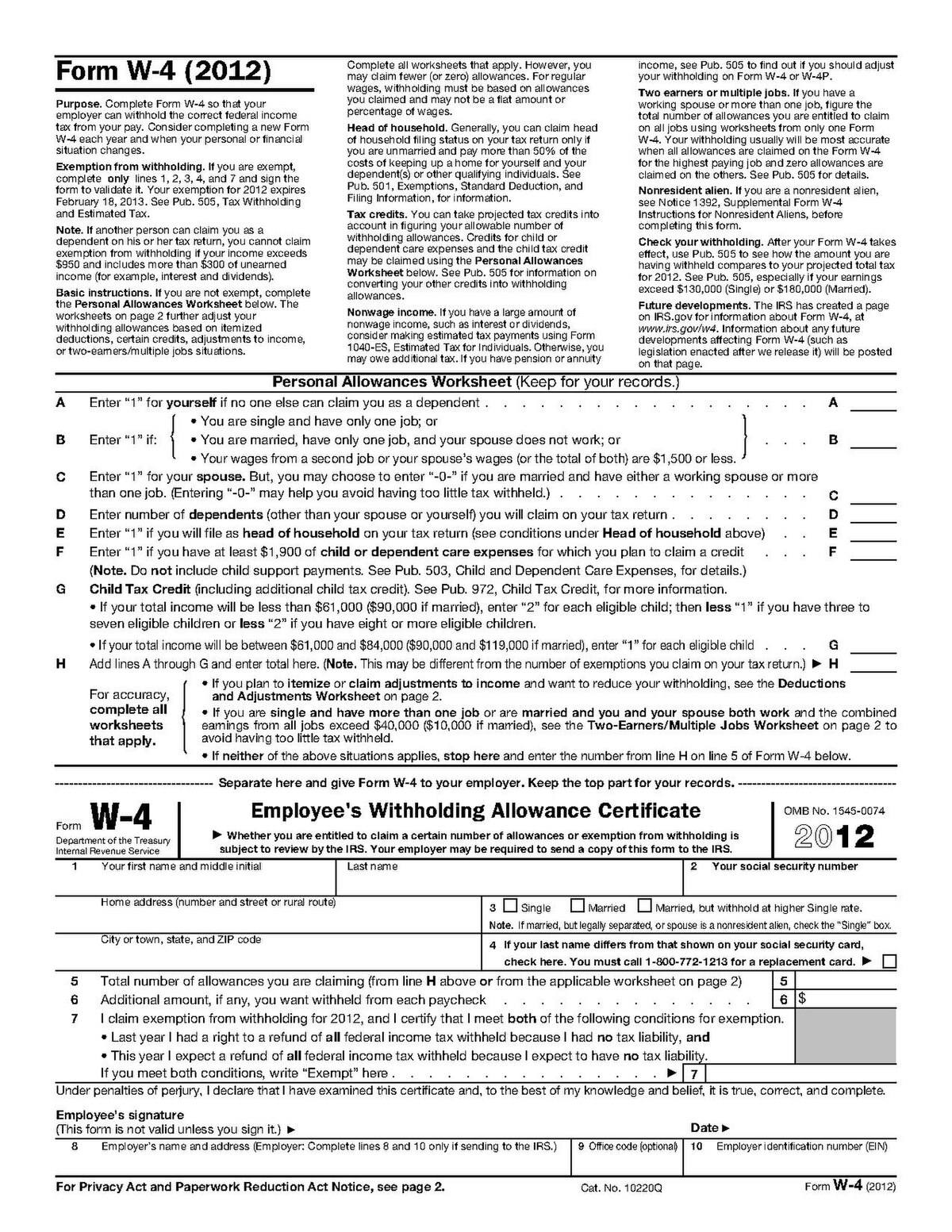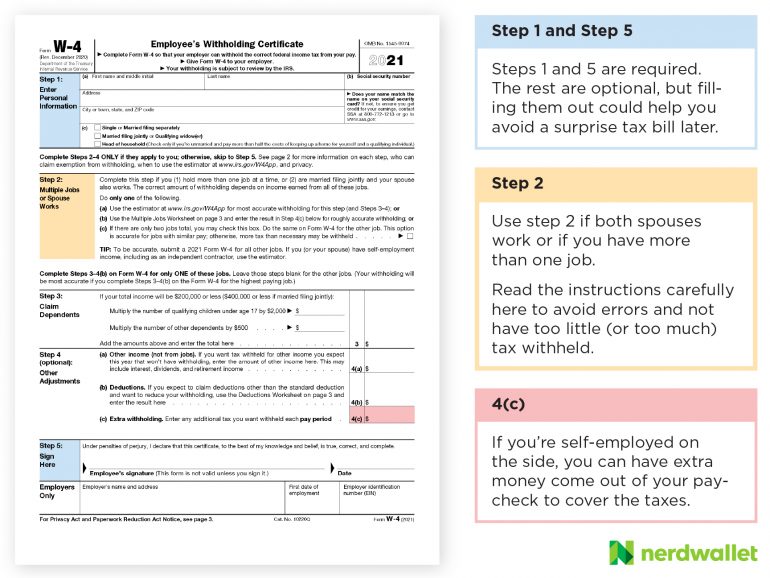W 4 Single Example
Updated January 12, 2021
All new employees need to fill out the new Form W-4, Employee’s Withholding Certificate once they are hired. Filling out the form accurately is the responsibility of the employee, and the employer must accept the completed form as it is filled out. If an employer does not receive a completed Form W-4 from an employee, they are authorized to withhold federal income tax at the Single – No Deductions rate.
2020 W-4 SAMPLE - claiming 'single'.pdf This sample document provides instructions on how to complete 2020 W-4 federal tax withholding certificate if an employee has evaluated their tax situation and determined that claiming 'single' is appropriate for their situation. Don’t forget to sign the W-4 and turn it into your employer! The allowances you claim while filling out a W-4 if you are single will differ from the allowances you claim if you are married or have kids. Claiming zero allowances. The maximum amount of tax is withheld. What is the purpose of the redesign? The purpose of the updated form is to better match the. 10220Q Form W-4 (2020) Example: to file single withholding (similar formally to filing 0) Complete highlighted areas, check single box (c), sign and date Leave blank Leave blank Leave blank Leave blank. If your employer doesn’t have a W-4 form from you, the IRS requires it to treat you as a single tax filer, which means withholding the highest possible amount from your paycheck for taxes. You can get back the amount you overpay, but only in the new year when you file your tax return.
Filling a W-4 out incorrectly can mean employees have unexpected tax liabilities at the end of the year, so encourage them to take their time and follow the instructions carefully.
What is a W-4?
The new form has a five-step process and new Publication 15-T (Federal Income Tax Withholding Methods) for determining employee withholding. It no longer uses withholding allowances. A W-4 should be filled out by all employees when they are hired, or whenever their life or financial situation changes. For instance, some employees may want to fill out a new W-4 if they work a second job, get married, have a child, or get divorced.
Instructions for filling out a W-4
As an employer, you can answer some general questions about W-4s for employees, but you can not fill out the form for your employee, nor can you suggest what impact their selections will have on their taxes.
These are the steps your employee will need to follow:
Step 1: Personal Information
Your employee will enter their personal information including name, address, and their filing status. Note that for any employee who does not have a completed W-4 on file, you will calculate withholdings at the higher “Single” rate.
Step 2: Multiple jobs or spouse works (optional)

This section applies to employees who have more than one job or are married and filing jointly with a working spouse. The IRS offers some guidance here for employees to determine whether they need to complete this step and where to look for additional instructions. Option (a) provides the most privacy for the employee’s information, according to the IRS, as well as the most accurate calculations.
Step 3: Claim dependents (optional)

If your employee has dependents, they will complete this section. Single taxpayers with an income of $200,000 or less ($400,000 if married filing jointly) are now eligible for the child tax credit as a result of the TCJA as well.
Step 4: Other adjustments (optional)
Here, the employee can account for other income not from jobs or add in additional deductions or withholdings.
Step 5: Signature
The employee will sign and date the form, and you will complete the Employer section.
When should a W-4 be completed?

Form W-4 should be filled out by every new employee preferably on their first day of employment, but no later than their first week. You do not need to file your employees’ W-4 forms with the IRS, but they should be kept on file with other personnel records for a minimum of four years. Payroll software providers often offer options for the employee to complete this paperwork entirely online — and often before their first day so you can get to training right away.
If you’re filling out a Form W-4, you probably just started a new job. Or maybe you recently got married or had a baby. The W-4, also called the Employee’s Withholding Certificate, tells your employer how much federal income tax to withhold from your paycheck. The form was redesigned for 2020, which is why it looks different if you’ve filled one out before then. The biggest change is that it no longer talks about “allowances,” which many people found confusing. Instead, if you want an additional amount withheld (perhaps your spouse earns considerably more than you), you simply state the amount per pay period. Here, we answer frequently asked questions about the W-4, including how to fill it out, what’s changed and how the W-4 is different from the W-2.
Go beyond taxes to build a comprehensive financial plan. Find a local financial advisor today.
Why Do I Need to Fill Out Form W-4?
As just noted, the form tells your employer how much federal income tax to withhold from your paycheck. You’ll need to complete a new W-4 every time you start a new job. If your new company forgets to give you one for some reason, be sure to ask. If your employer doesn’t have a W-4 form from you, the IRS requires it to treat you as a single tax filer, which means withholding the highest possible amount from your paycheck for taxes. You can get back the amount you overpay, but only in the new year when you file your tax return.
Do I Need to Submit the New Form W-4?
You should complete the redesigned W-4 only if you started a new job – or if your filing status or financial situation has changed. You do not need to fill out the new form if you have not changed employers. Your company can still use the information provided on the old W-4 form.
How Long Does It Take for W-4 Changes to Be Implemented?
When you submit a W-4, you can expect the information to go into effect fairly quickly. But how long exactly before your paycheck reflects the changes largely depends on your payroll system. Ask your employer when you turn in the form.
How Is the New W-4 Different from the Old W-4?
The biggest change is the removal of the allowances section. You no longer need to calculate how many allowances to claim to increase or decrease your withholding. The new form instead asks you to indicate whether you have more than one job or if your spouse works; how many dependents you have, and if you have other income (not from jobs), deductions or extra withholding. The new form also provides more privacy in the sense that if you do not want your employer to know you have more than one job, you do not turn in the multiple job worksheet.
How to Fill Out the W-4?
As far as IRS forms go, the new W-4 form is pretty straightforward. It has only five steps. If you are single, have one job, have no children, have no other income and plan on claiming the standard deduction on your tax return, you only need to fill out Step 1 (your name, address, Social Security number and filing status) and Step 5 (your signature).
If you have more than one job or your spouse works, you’ll need to fill out Step 2. If you have children, Step 3 applies to you. And if you have other income (not from jobs), you’ll be itemizing your deductions on your tax return or you want an extra amount withheld (including from other jobs), you can indicate your adjustments in Step 4.
How to Fill Out Step 2: Multiple Jobs or Spouse Works?
If your spouse works and you file jointly or if you have a second or third job, you can use either the IRS app or the two-earners/multiple jobs worksheet (page three of the W-4 instructions) to calculate how much extra should be withheld (you put this amount in Step 4). If there are only two jobs (i.e., you and your spouse each have a job, or you have two), you just check the box. (Your spouse should do the same on his or her form or you check the box on the W-4 for the other job, too.)
How to Fill Out Step 3: Claim Dependents?
You fill this out if you earn $200,000 or less (or $400,000 or less for joint filers) and have dependents. It’s a simple calculation where you multiply the number of children under age 17 by $2,000 and the number of other dependents by $500 – and add the two sums.
How to Fill Out Step 4a: Other Income (Not from Jobs)?
If you have interest, dividends or capital gains that you’ll owe taxes on, you can indicate here the total amount of non-pay income here. Your employer will figure it into how much taxes to withhold from your paycheck.
How to Fill Out Step 4b: Deductions?
The deductions worksheet requires some math. You’ll also need to know how much you claimed in deductions on your last tax return. If you claimed the standard deduction, you don’t need to fill this out. If you claimed more than the standard amount, this worksheet will help you calculate how much more. Once you have this amount, you add any student loan interest, deductible IRA contributions and certain other adjustments. You then put this total on the form.
If you get stuck, use the IRS’s withholding app.
How to Fill Out Step 4c: Extra Withholding?
If you will owe more in taxes than what your salary alone would indicate, you can say here how much more you want withheld per pay period. If the extra amount is because your spouse works or because you have more than one job, you enter the amount you calculated in Step 2 – plus any other amount you want withheld.
How Does the W-4 Form Differ From the W-2?
Yes, both of these forms start with the letter ‘w,’ but that’s where the similarities end.
Unlike a W-4, a W-2 form is what your employer fills out for all employees and files with the IRS. It shows your annual earnings from wages and tips. It also states the amounts withheld for the year for Social Security, Medicare, state, local and federal income taxes.
W 4 Single Example Words
The Bottom Line
W 4 Single Example Single
If you aren’t switching jobs or going through life changes, you don’t need to refile your W-4 just because the form has changed. However, all new employees need to fill out a W-4 to avoid overpaying taxes. While the form is more straightforward and doesn’t include allowances like it did in the past, it’s still important to properly and accurately list information on your W-4.
Tax Planning and Your Financial Plan
W 4 Single Example Sentences
- Income taxes are just one aspect of tax planning. If you want to preserve what you’ve earned and grow it in the most tax-efficient way, a financial advisor can help. To find a financial advisor to work with, use SmartAsset’s free tool. It connects you with up to three advisors in your area. If you’re ready to be matched with local advisors, get started now.
- Starting a new job? Even before you fill out your W-4, you can get an estimate for how much your take-home pay will be. Just use our paycheck calculator.
W-4 Single 0 Example
Photo credit: IRS.gov ©iStock.com/PeopleImages, ©iStock.com/wdstock